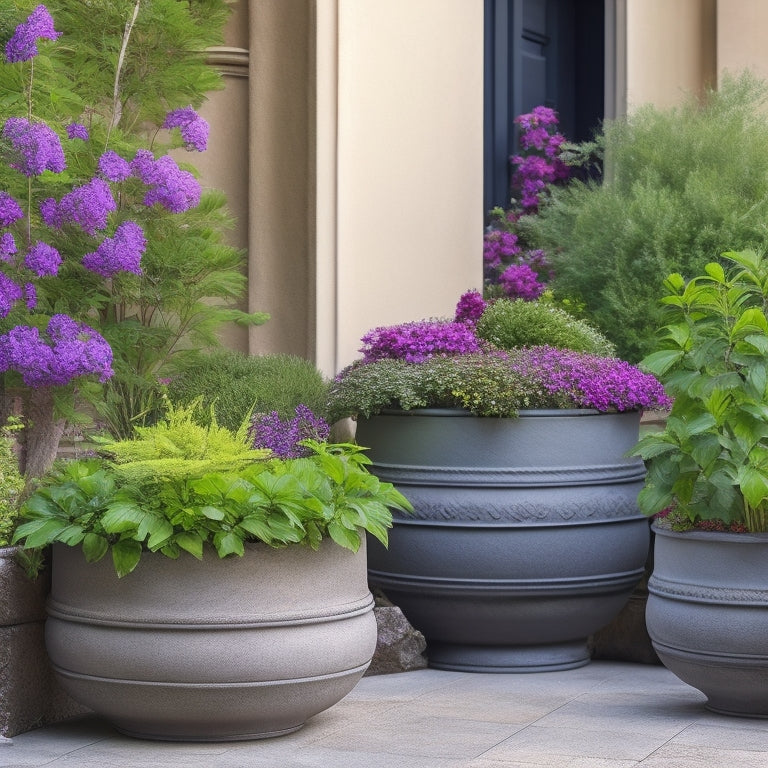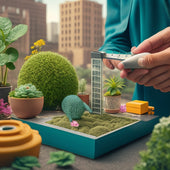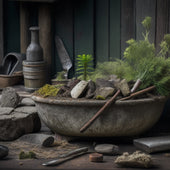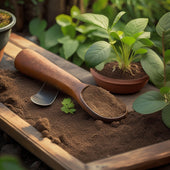
5 Outdoor Design Tips for Creative Concrete Planters
Share
When you're ready to elevate your outdoor space, concrete planters offer a versatile and stylish solution. You'll discover that selecting the right cinder blocks is just the beginning; proper soil preparation and drainage are essential for your plants to thrive. As you explore various planter layouts, from geometric to organic forms, you'll find that adding color and texture through mosaics and finishes can truly make your creations pop. But what plants will best complement your design and flourish in your climate? Let's uncover the secrets to crafting vibrant, cohesive concrete planters that'll transform your outdoor oasis.
Key Takeaways
- Select cinder blocks in various sizes and shapes to achieve desired aesthetic.
- Prepare planting space with proper soil preparation and drainage solutions to ensure plant health.
- Design planter layout with creativity, considering shapes, styles, and spacing for visual interest.
- Add color and texture to planters using mosaics, finishes, or imprinted patterns for enhanced design.
- Choose plants that complement planter design and climate, and maintain with appropriate watering techniques.
Thank you for your quick and precise bullet points. They effectively capture the key aspects of designing creative concrete planters for outdoor spaces. Your list remains clear and directly addresses the query's intent.
Choose Your Cinder Blocks
Cinder blocks, the backbone of your concrete planter project, come in various sizes and shapes. You'll find yourself pondering over the selection, from the standard rectangular blocks to the more decorative options with curved edges or patterns.
When you're choosing, consider the overall aesthetic you're aiming for. Do you want a clean, modern look or a more rustic feel? Your choice of block styles will set the tone.
Don't forget about drainage solutions. You don't want your plants sitting in waterlogged soil. Some blocks come with pre-drilled holes, while others will require you to drill them yourself.
If you're feeling particularly innovative, consider creating a layered look with different sized blocks, incorporating gaps for drainage and visual interest.
As you select your cinder blocks, remember that they're not just functional; they're a key design element in your project. Choose wisely, and you'll set the stage for a stunning concrete planter that's both practical and visually appealing.
Prepare Your Planting Space
With your cinder blocks selected, it's time to turn your attention to preparing the space where your concrete planter will live.
First, you'll want to guarantee proper soil preparation. This means removing any weeds, rocks, or debris from the area, and then tilling the soil to a depth of at least six inches. This will provide a loose, aerated base for your planter, allowing roots to grow freely.
Next, consider your drainage solutions. You don't want water to pool in your planter, as this can lead to root rot and other issues.
One option is to place a layer of gravel or sand at the bottom of your planter before adding soil. This will allow water to drain freely. Alternatively, you could drill drainage holes in the bottom of your cinder blocks, ensuring water can escape.
Design Your Planter Layout
Your planter layout is a blank canvas awaiting your creative touch. When designing your layout, you'll want to take into account various planter shapes and layout styles to create a visually stunning and cohesive design.
Experiment with geometric shapes like rectangles, squares, and circles, or opt for more organic, free-form shapes to add a touch of whimsy to your space.
Don't be afraid to mix and match different planter shapes and sizes to create depth and visual interest. You can arrange them in a symmetrical pattern for a more formal look or opt for an asymmetrical layout for a more casual, organic feel.
When it comes to layout styles, think about using a grid pattern for a modern, streamlined look or a staggered, offset pattern for a more dynamic, visually engaging design.
You can also play with the spacing between planters to create different effects – clustering them closely together for a lush, abundant look or spacing them further apart for a more minimalist, sculptural effect.
Add Color and Texture
Color and texture are the lifeblood of any outdoor design. You can revolutionize your concrete planters with vibrant hues and intricate textures that breathe life into your outdoor spaces.
Start by considering colorful mosaics. These can be created using a variety of materials such as glass, ceramic, or even brightly colored stones. You'll be amazed at how these small pieces can come together to form intricate designs that catch the eye and spark the imagination.
Don't stop at color, though. Textured finishes can add another dimension to your planters. You might opt for a rough, rustic finish that emulates the look of natural stone.
Alternatively, a smooth, polished surface can provide a sleek, modern contrast to the organic forms of the plants within. You can even experiment with imprinting patterns into the concrete while it's still wet, creating a one-of-a-kind texture that's uniquely yours.
Plant and Maintain Greenery
Introducing greenery into your concrete planters is an essential step in creating a vibrant and thriving outdoor space.
You'll want to carefully consider your plant selection, opting for varieties that not only complement the design of your planters but also thrive in your specific climate. Don't be afraid to mix textures and colors; combining sprawling vines with upright shrubs can add depth and interest to your arrangement.
When it comes to maintenance, watering techniques are vital. Concrete planters tend to retain moisture, so you'll need to adjust your watering schedule to prevent overwatering.
A good rule of thumb is to water thoroughly and then let the soil dry out slightly before the next watering. This encourages plants to develop deeper roots, making them more resilient.
Conclusion
So, you've journeyed through the domains of concrete creativity, turning mere cinder blocks into vibrant green havens. Now, maintain your botanical masterpiece with diligence, for in this modern age, our thumbs are more tech-savvy than green. Yet, with care, your concrete planters will flourish, a proof of your imaginative prowess. May your garden thrive, a lush legacy of your artistic endeavors.
Related Posts
-

10 Essential Tips for Sizing Block Planters Perfectly
When sizing block planters, you need to take into account multiple factors to get it just right. Measure your cinder ...
-

10 Essential Tips for Sizing Block Planters Perfectly
When sizing block planters, you need to take into account multiple factors to get it just right. Measure your cinder ...
-

10 Essential Tips for Sizing Block Planters Perfectly
When sizing block planters, you need to take into account multiple factors to get it just right. Measure your cinder ...
-

10 Essential Tips for Sizing Block Planters Perfectly
When sizing block planters, you need to take into account multiple factors to get it just right. Measure your cinder ...
-

10 Essential Tips for Sizing Block Planters Perfectly
When sizing block planters, you need to take into account multiple factors to get it just right. Measure your cinder ...
-

10 Essential Tips for Sizing Block Planters Perfectly
When sizing block planters, you need to take into account multiple factors to get it just right. Measure your cinder ...
-

10 Essential Tips for Sizing Block Planters Perfectly
When sizing block planters, you need to take into account multiple factors to get it just right. Measure your cinder ...
-

10 Essential Tips for Sizing Block Planters Perfectly
When sizing block planters, you need to take into account multiple factors to get it just right. Measure your cinder ...
-

10 Essential Tips for Sizing Block Planters Perfectly
When sizing block planters, you need to take into account multiple factors to get it just right. Measure your cinder ...
-

10 Essential Tips for Sizing Block Planters Perfectly
When sizing block planters, you need to take into account multiple factors to get it just right. Measure your cinder ...
-

10 Essential Tips for Sizing Block Planters Perfectly
When sizing block planters, you need to take into account multiple factors to get it just right. Measure your cinder ...
-

10 Essential Tips for Sizing Block Planters Perfectly
When sizing block planters, you need to take into account multiple factors to get it just right. Measure your cinder ...
-

10 Essential Tips for Sizing Block Planters Perfectly
When sizing block planters, you need to take into account multiple factors to get it just right. Measure your cinder ...
-

10 Essential Tips for Sizing Block Planters Perfectly
When sizing block planters, you need to take into account multiple factors to get it just right. Measure your cinder ...
-

10 Essential Tips for Sizing Block Planters Perfectly
When sizing block planters, you need to take into account multiple factors to get it just right. Measure your cinder ...
-

10 Essential Tips for Sizing Block Planters Perfectly
When sizing block planters, you need to take into account multiple factors to get it just right. Measure your cinder ...
-

10 Essential Tips for Sizing Block Planters Perfectly
When sizing block planters, you need to take into account multiple factors to get it just right. Measure your cinder ...
-

10 Essential Tips for Sizing Block Planters Perfectly
When sizing block planters, you need to take into account multiple factors to get it just right. Measure your cinder ...
-

10 Essential Tips for Sizing Block Planters Perfectly
When sizing block planters, you need to take into account multiple factors to get it just right. Measure your cinder ...
-

10 Essential Tips for Sizing Block Planters Perfectly
When sizing block planters, you need to take into account multiple factors to get it just right. Measure your cinder ...
-

10 Essential Tips for Sizing Block Planters Perfectly
When sizing block planters, you need to take into account multiple factors to get it just right. Measure your cinder ...
-

10 Essential Tips for Sizing Block Planters Perfectly
When sizing block planters, you need to take into account multiple factors to get it just right. Measure your cinder ...
-

10 Essential Tips for Sizing Block Planters Perfectly
When sizing block planters, you need to take into account multiple factors to get it just right. Measure your cinder ...
-

10 Essential Tips for Sizing Block Planters Perfectly
When sizing block planters, you need to take into account multiple factors to get it just right. Measure your cinder ...
-

10 Essential Tips for Sizing Block Planters Perfectly
When sizing block planters, you need to take into account multiple factors to get it just right. Measure your cinder ...
-

10 Essential Tips for Sizing Block Planters Perfectly
When sizing block planters, you need to take into account multiple factors to get it just right. Measure your cinder ...
-

10 Essential Tips for Sizing Block Planters Perfectly
When sizing block planters, you need to take into account multiple factors to get it just right. Measure your cinder ...
-

10 Essential Tips for Sizing Block Planters Perfectly
When sizing block planters, you need to take into account multiple factors to get it just right. Measure your cinder ...
-

10 Essential Tips for Sizing Block Planters Perfectly
When sizing block planters, you need to take into account multiple factors to get it just right. Measure your cinder ...
-

10 Essential Tips for Sizing Block Planters Perfectly
When sizing block planters, you need to take into account multiple factors to get it just right. Measure your cinder ...
-

10 Essential Tips for Sizing Block Planters Perfectly
When sizing block planters, you need to take into account multiple factors to get it just right. Measure your cinder ...
-

10 Essential Tips for Sizing Block Planters Perfectly
When sizing block planters, you need to take into account multiple factors to get it just right. Measure your cinder ...
-

10 Essential Tips for Sizing Block Planters Perfectly
When sizing block planters, you need to take into account multiple factors to get it just right. Measure your cinder ...
-

10 Essential Tips for Sizing Block Planters Perfectly
When sizing block planters, you need to take into account multiple factors to get it just right. Measure your cinder ...
-

10 Essential Tips for Sizing Block Planters Perfectly
When sizing block planters, you need to take into account multiple factors to get it just right. Measure your cinder ...
-

10 Essential Tips for Sizing Block Planters Perfectly
When sizing block planters, you need to take into account multiple factors to get it just right. Measure your cinder ...
-

10 Essential Tips for Sizing Block Planters Perfectly
When sizing block planters, you need to take into account multiple factors to get it just right. Measure your cinder ...
-

10 Essential Tips for Sizing Block Planters Perfectly
When sizing block planters, you need to take into account multiple factors to get it just right. Measure your cinder ...
-

What to Know Before Upcycling Concrete Planters
When upcycling concrete planters, you'll want to start by evaluating the planter's size, shape, and condition to guar...
-

What to Know Before Upcycling Concrete Planters
When upcycling concrete planters, you'll want to start by evaluating the planter's size, shape, and condition to guar...
-

What to Know Before Upcycling Concrete Planters
When upcycling concrete planters, you'll want to start by evaluating the planter's size, shape, and condition to guar...
-

What to Know Before Upcycling Concrete Planters
When upcycling concrete planters, you'll want to start by evaluating the planter's size, shape, and condition to guar...
-

What to Know Before Upcycling Concrete Planters
When upcycling concrete planters, you'll want to start by evaluating the planter's size, shape, and condition to guar...
-

What to Know Before Upcycling Concrete Planters
When upcycling concrete planters, you'll want to start by evaluating the planter's size, shape, and condition to guar...
-

What to Know Before Upcycling Concrete Planters
When upcycling concrete planters, you'll want to start by evaluating the planter's size, shape, and condition to guar...
-

What to Know Before Upcycling Concrete Planters
When upcycling concrete planters, you'll want to start by evaluating the planter's size, shape, and condition to guar...
-

What to Know Before Upcycling Concrete Planters
When upcycling concrete planters, you'll want to start by evaluating the planter's size, shape, and condition to guar...
-

What to Know Before Upcycling Concrete Planters
When upcycling concrete planters, you'll want to start by evaluating the planter's size, shape, and condition to guar...
-

What to Know Before Upcycling Concrete Planters
When upcycling concrete planters, you'll want to start by evaluating the planter's size, shape, and condition to guar...
-

What to Know Before Upcycling Concrete Planters
When upcycling concrete planters, you'll want to start by evaluating the planter's size, shape, and condition to guar...
-

What to Know Before Upcycling Concrete Planters
When upcycling concrete planters, you'll want to start by evaluating the planter's size, shape, and condition to guar...
-

What to Know Before Upcycling Concrete Planters
When upcycling concrete planters, you'll want to start by evaluating the planter's size, shape, and condition to guar...
-

What to Know Before Upcycling Concrete Planters
When upcycling concrete planters, you'll want to start by evaluating the planter's size, shape, and condition to guar...
-

What to Know Before Upcycling Concrete Planters
When upcycling concrete planters, you'll want to start by evaluating the planter's size, shape, and condition to guar...
-

What to Know Before Upcycling Concrete Planters
When upcycling concrete planters, you'll want to start by evaluating the planter's size, shape, and condition to guar...
-

What to Know Before Upcycling Concrete Planters
When upcycling concrete planters, you'll want to start by evaluating the planter's size, shape, and condition to guar...
-

What to Know Before Upcycling Concrete Planters
When upcycling concrete planters, you'll want to start by evaluating the planter's size, shape, and condition to guar...
-

What to Know Before Upcycling Concrete Planters
When upcycling concrete planters, you'll want to start by evaluating the planter's size, shape, and condition to guar...
-

What to Know Before Upcycling Concrete Planters
When upcycling concrete planters, you'll want to start by evaluating the planter's size, shape, and condition to guar...
-

What to Know Before Upcycling Concrete Planters
When upcycling concrete planters, you'll want to start by evaluating the planter's size, shape, and condition to guar...
-

What to Know Before Upcycling Concrete Planters
When upcycling concrete planters, you'll want to start by evaluating the planter's size, shape, and condition to guar...
-

What Makes a Good Used Trowel for Planters
When searching for a good used trowel for planters, you'll want to prioritize corrosion-resistant materials like stai...
-

What Makes a Good Used Trowel for Planters
When searching for a good used trowel for planters, you'll want to prioritize corrosion-resistant materials like stai...
-

What Makes a Good Used Trowel for Planters
When searching for a good used trowel for planters, you'll want to prioritize corrosion-resistant materials like stai...
-

What Makes a Good Used Trowel for Planters
When searching for a good used trowel for planters, you'll want to prioritize corrosion-resistant materials like stai...
-

What Makes a Good Used Trowel for Planters
When searching for a good used trowel for planters, you'll want to prioritize corrosion-resistant materials like stai...
-

What Makes a Good Used Trowel for Planters
When searching for a good used trowel for planters, you'll want to prioritize corrosion-resistant materials like stai...
-

What Makes a Good Used Trowel for Planters
When searching for a good used trowel for planters, you'll want to prioritize corrosion-resistant materials like stai...
-

What Makes a Good Used Trowel for Planters
When searching for a good used trowel for planters, you'll want to prioritize corrosion-resistant materials like stai...
-

What Makes a Good Used Trowel for Planters
When searching for a good used trowel for planters, you'll want to prioritize corrosion-resistant materials like stai...
-

What Makes a Good Used Trowel for Planters
When searching for a good used trowel for planters, you'll want to prioritize corrosion-resistant materials like stai...
-

What Makes a Good Used Trowel for Planters
When searching for a good used trowel for planters, you'll want to prioritize corrosion-resistant materials like stai...
-

What Makes a Good Used Trowel for Planters
When searching for a good used trowel for planters, you'll want to prioritize corrosion-resistant materials like stai...
-

What Makes a Good Used Trowel for Planters
When searching for a good used trowel for planters, you'll want to prioritize corrosion-resistant materials like stai...
-

What Makes a Good Used Trowel for Planters
When searching for a good used trowel for planters, you'll want to prioritize corrosion-resistant materials like stai...
-

What Makes a Good Used Trowel for Planters
When searching for a good used trowel for planters, you'll want to prioritize corrosion-resistant materials like stai...
-

What Makes a Good Used Trowel for Planters
When searching for a good used trowel for planters, you'll want to prioritize corrosion-resistant materials like stai...
-

What Makes a Good Used Trowel for Planters
When searching for a good used trowel for planters, you'll want to prioritize corrosion-resistant materials like stai...
-

What Makes a Good Used Trowel for Planters
When searching for a good used trowel for planters, you'll want to prioritize corrosion-resistant materials like stai...
-

What Makes a Good Used Trowel for Planters
When searching for a good used trowel for planters, you'll want to prioritize corrosion-resistant materials like stai...
-

What Makes a Good Used Trowel for Planters
When searching for a good used trowel for planters, you'll want to prioritize corrosion-resistant materials like stai...
-

What Makes a Good Used Trowel for Planters
When searching for a good used trowel for planters, you'll want to prioritize corrosion-resistant materials like stai...
-

What Makes a Good Used Trowel for Planters
When searching for a good used trowel for planters, you'll want to prioritize corrosion-resistant materials like stai...
-

What Makes a Good Used Trowel for Planters
When searching for a good used trowel for planters, you'll want to prioritize corrosion-resistant materials like stai...
-

What Makes a Good Used Trowel for Planters
When searching for a good used trowel for planters, you'll want to prioritize corrosion-resistant materials like stai...


